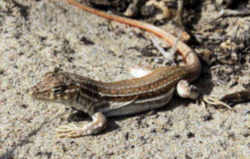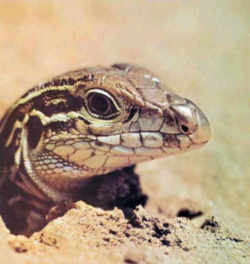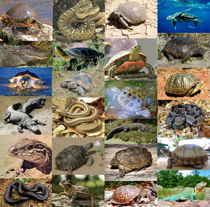
New Mexico Symbols
New Mexico State Reptile
New Mexico Whiptail Lizard

(Cnemidophorus neomexicanus)
Adopted in 2003.
The New Mexico Whiptail Lizard (Cnemidophorus neomexianus) was first recognized by science from a specimen collected in Socorro County in 1947. It became the official New Mexico state reptile when Governor Bill Richardson signed HB 13 on April 6, 2003.
This 7-striped whiptail is identified by having a wavy vertebral stripe with spots on the sides between the lighter stripes. The tail is gray at the base occurring as greenish to greenish blue toward the tip. The underside of the animal is white to pale blue.
It occurs mostly in the Rio Grande Valley from Espanola south to Presidio County, Texas, into adjacent Mexico and in the southwestern part of the state to western Hidalgo County. It also occurs in the Tularosa Basin. New Mexico Whiptail prefer disturbed riverside habitats and desert-grassland areas.
This species is active during the day, often retreating from the heat from noon until mid-afternoon during periods of high temperatures. They hibernate but are active from mid-March through mid-October. New Mexico Whiptail feed heavily on moths, butterflies, beetles, insect larvae, grasshoppers and ants. They hunt in short, jerky movements but can move rapidly in pursuit of prey or to avoid being eaten.
New Mexico State Reptile:
New Mexico Whiptail Lizard

The whiptail lizard is found from the northern Rio Grande valley south to northern Chihuahua, Mexico. The diurnal whiptail is in constant motion as it forages for insects among vegetation. The lizard is six to nine inches long, and its long tail is three times its combined head and body length. Its brown New Mexico Department of Game and Fish - Charlie Painter coloring is marked with pale yellow stripes and light spots between the stripes. This species is exclusively female - reproduction occurs through parthenogenesis, a process in which an unfertilized egg develops into a new individual. The whiptail lizard was adopted as the official state reptile by the legislature in 2003.
The spotted whiptail (C. burti) is has a long body and tail, and rapid movements. C. burti has two recognized subspecies in Arizona: the red-backed whiptail (C. burti xanthonotus) and the giant spotted whiptail (C. burti stictogrammus). C.b. stictogrammus grows to 3.5 to 5.5 inches. The upperpart of the lizard is usually medium to grayish brown and may have a reddish tint on the head and neck Adults have large spots with little to no side striping. C.b. xanthonotus does not grow as large as C.b. stictogrammus. The upperpart is reddish with the coloring abruptly stopping at the sides. The sides and upperparts of the neck, legs, and feet are grayish-green or bluish.
- Habitat: C.b. stictogrammus and C.b. xanthonotus occur among dense, shrubby vegetation near the banks of semi-arid permanent streams and intermittent streams.
- Range: C.b. stictogrammus ranges from southern and southeastern Arizona, extreme southwestern New Mexico, and Sonora, Mexico. C.b. xanthonotus ranges from the Ajo Mountain area in Pima County, to the Sierra Estrella in Maricopa County, Arizona.
- Diet: Both subspecies of lizards feed on beetles, scorpions, spiders, and other small arthropods.
- Life History: Both subspecies are active during the day, foraging in litter and dense vegetation to find insects. The lizards are active spring through autumn and hibernate during the winter. During the summer, the female lays a clutch of one to four eggs.
New Mexico Law
The law designating the New Mexico whiptail lizard as the official New Mexico state reptile is found in the 2013 New Mexico Statutes, Article 3, Section 12-4-4 P.
Chapter 12 - Miscellaneous Public Affairs Matters
Article 3 - State Seal, Song and Symbols
Section 12-3-4 - State flower; state bird; state tree; state fish; state animal; state vegetables; state gem; state grass; state fossil; state cookie;
state insect; state question; state answer; state nickname; state butterfly; state reptile; state amphibian; state amphibian; state aircraft; state
historic railroad; state tie; state necklace.
Universal Citation: NM Stat § 12-3-4 (2013)
12-3-4. State flower; state bird; state tree; state fish; state animal; state vegetables; state gem; state grass; state fossil; state cookie; state
insect; state question; state answer; state nickname; state butterfly; state reptile; state amphibian; state aircraft; state historic railroad; state
tie; state necklace. (2011)
A. The yucca flower is adopted as the official flower of New Mexico.
B. The chaparral bird, commonly called roadrunner, is adopted as the official bird of New Mexico.
C. The nut pine or pinon tree, scientifically known as Pinus edulis, is adopted as the official tree of New Mexico.
D. The native New Mexico cutthroat trout is adopted as the official fish of New Mexico.
E. The native New Mexico black bear is adopted as the official animal of New Mexico.
F. The chile, the Spanish adaptation of the chilli, and the pinto bean, commonly known as the frijol, are adopted as the official vegetables of New
Mexico.
G. The turquoise is adopted as the official gem of New Mexico.
H. The blue grama grass, scientifically known as Bouteloua gracillis, is adopted as the official grass of New Mexico.
I. The coelophysis is adopted as the official fossil of New Mexico.
J. The bizcochito is adopted as the official cookie of New Mexico.
K. The tarantula hawk wasp, scientifically known as Pepsis formosa, is adopted as the official insect of New Mexico.
L. "Red or green?" is adopted as the official question of New Mexico.
M. "Red and green or Christmas" is adopted as the official answer of New Mexico.
N. "The Land of Enchantment" is adopted as the official nickname of New Mexico.
O. The Sandia hairstreak is adopted as the official butterfly of New Mexico.
P. The New Mexico whiptail lizard, scientifically known as Cnemidophorus neomexicanus, is adopted as the official reptile of New Mexico.
Q. The New Mexico spadefoot toad, scientifically known as Spea multiplicata, is adopted as the official amphibian of New Mexico.
R. The hot air balloon is adopted as the official aircraft of New Mexico.
S. The Cumbres and Toltec scenic railroad is adopted as the official historic railroad of New Mexico.
T. The bolo tie is adopted as the official tie of New Mexico.
U. The Native American squash blossom necklace is adopted as the official necklace of New Mexico.
History: Laws 1927, ch. 102, § 1; C.S. 1929, § 129-101; 1941 Comp., § 3-1303; Laws 1949, ch. 142, § 1; 1953 Comp., § 4-14-3;
Laws 1955, ch. 245, § 1; 1963, ch. 2, § 1; 1965, ch. 20, § 1; 1967, ch. 51, § 1; 1967, ch. 118, § 1; 1973, ch. 95, §
1; 1981, ch. 123, § 1; 1989, ch. 8, § 1; 1989, ch. 154, § 1; 1999, ch. 266, § 1; 1999, ch. 271, § 1; 2003, ch. 182, §
1; 2005, ch. 4, § 1; 2005, ch. 254, § 1; 2007, ch. 10, § 1; 2007, ch. 179, § 1; 2011, ch. 52, § 1.
Taxonomic Hierarchy: New Mexico Whiptail Lizard
Kingdom: Animalia
Phylum: Chordata
Class: Reptilia
Order: Squamata
Suborder: Sauria
Family:Teiidae
Genus: Cnemidophorus
Species: C. neomexicanus







